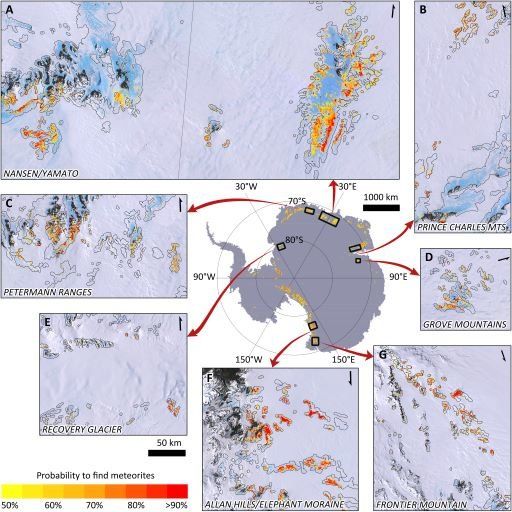Meteorites are known to fall all over the world, but the environment and unique processes in Antarctica make them somewhat easier to find in the pristine, snowy landscape. However, collecting meteorites in Antarctica is physically exhausting and dangerous.
But what if we had a “treasure map” that showed the most likely places to find meteorites in Antarctica, directing researchers to where to look?
Researchers at the Delft University of Technology in the Netherlands are using artificial intelligence to create a kind of treasure map to identify areas where meteorites are likely to be found.
“We learned from our analysis that satellite observations of temperature, ice speed, snow cover and geometry are good indicators of the location of meteorite-rich areas,” said Veronica Tollenaar, who led the study, published in Science Advances. . “We expect the treasure map to be eighty percent accurate.”
Based on the study, scientists estimate that more than 300,000 meteorites are somewhere in the Antarctic landscape and are waiting to be discovered. This represents a huge scientific potential.
“We found several never-before-visited meteorite-rich areas that are relatively close to research stations,” said Stef Lhermitte, a study participant at Delft University of Technology.
Rocks from space have been accumulating in Antarctica for millennia, preserved in the cold, desert climate of the continent. Meteorites fall and build up in the ice sheet in the interior of the continent. Glaciers flow slowly and carry meteorites with them. If a glacier collides with a large obstacle, in places like the Trans-Antarctic Mountains, the ice rises and meteorites rise to the surface.
In addition, dry Antarctic winds are gradually eating away at the ice, exposing meteorites. The ice rises to the surface and the process is repeated. With enough time, a significant amount of meteorites accumulate.
Meteorites are too small to be detected separately from space, but with indirect satellite measurements such as temperature, ice flow velocity, surface slope and the way ice reflects radar signals, processing all this data and using machine learning, the researchers found that they can predict where meteorites are concentrated on the surface.
One of the areas known to contain meteorites is in the areas of blue ice on the continent. Contrasting blue ice makes it easier to detect and collect meteorites during Antarctic field missions.
Photo: Map of Antarctic meteorite hotspots with positively classified observations. In the central overview map, the size of the positively classified observations is exaggerated by visual contrast, while in the sub-maps (A to G) the positively classified observations are scaled. The extended areas of blue ice (BIA) on which the classification is performed are outlined in black. The “probability of finding meteorites” in a place corresponds to the a posteriori (after the experiment) probability. Credit: Tollenaar et al.
Source: Simulation Predicts Where to Find 300,000 Meteorites Hidden in Antarctica, Universe Today
Reference: Unexplored Antarctic meteorite collection sites revealed through machine learning
Veronica Tollenaa, Harry Zekollari, Steff Lhermitte, David M.J. Tax, Vinciane Debaillesteven Goderis, Philippe Clayes and Frank Pattyn; Science Advances • 26 Jan 2022 • Vol 8, Issue 4 • DOI: 10.1126 / sciadv.abj8138













 English
English French
French Spanish
Spanish German
German Dutch
Dutch Italian
Italian Danish
Danish Portuguese
Portuguese Greek
Greek Russian
Russian Swedish
Swedish Bulgarian
Bulgarian Hungarian
Hungarian Catalan
Catalan Ukrainian
Ukrainian Polish
Polish Basque
Basque Chinese (Simplified)
Chinese (Simplified) Japanese
Japanese Hebrew
Hebrew Arabic
Arabic Swahili
Swahili Amharic
Amharic Irish
Irish Afrikaans
Afrikaans Albanian
Albanian Armenian
Armenian Azerbaijani
Azerbaijani Belarusian
Belarusian Bengali
Bengali Bosnian
Bosnian Cebuano
Cebuano Chichewa
Chichewa Chinese (Traditional)
Chinese (Traditional) Corsican
Corsican Croatian
Croatian Czech
Czech Esperanto
Esperanto Estonian
Estonian Filipino
Filipino Finnish
Finnish Frisian
Frisian Galician
Galician Georgian
Georgian Gujarati
Gujarati Haitian Creole
Haitian Creole Hausa
Hausa Hawaiian
Hawaiian Hindi
Hindi Hmong
Hmong Icelandic
Icelandic Igbo
Igbo Indonesian
Indonesian Javanese
Javanese Kannada
Kannada Kazakh
Kazakh Khmer
Khmer Korean
Korean Kurdish (Kurmanji)
Kurdish (Kurmanji) Kyrgyz
Kyrgyz Lao
Lao Latin
Latin Latvian
Latvian Lithuanian
Lithuanian Luxembourgish
Luxembourgish Macedonian
Macedonian Malagasy
Malagasy Malay
Malay Malayalam
Malayalam Maltese
Maltese Maori
Maori Marathi
Marathi Mongolian
Mongolian Myanmar (Burmese)
Myanmar (Burmese) Nepali
Nepali Norwegian
Norwegian Pashto
Pashto Persian
Persian Punjabi
Punjabi Romanian
Romanian Samoan
Samoan Scottish Gaelic
Scottish Gaelic Serbian
Serbian Sesotho
Sesotho Shona
Shona Sindhi
Sindhi Sinhala
Sinhala Slovak
Slovak Slovenian
Slovenian Somali
Somali Sundanese
Sundanese Tajik
Tajik Tamil
Tamil Telugu
Telugu Thai
Thai Turkish
Turkish Urdu
Urdu Uzbek
Uzbek Vietnamese
Vietnamese Welsh
Welsh Xhosa
Xhosa Yiddish
Yiddish Yoruba
Yoruba Zulu
Zulu